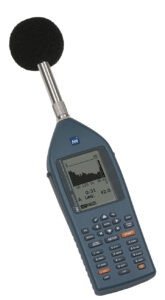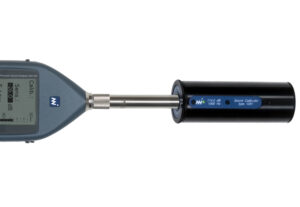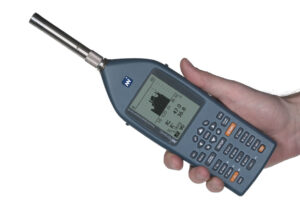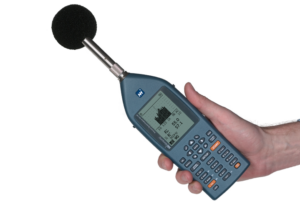Sound Analyser Nor140






A precision hand held sound level meter designed for the most demanding users.
The Nor140 is packed into the smallest real time analyser featuring sound recording present on the market today.
Overall Performance
The Nor140 fulfil the following standards set for sound level meters, 1/1-octave and 1/3 octave filters: IEC 61672-1:2002 class 1, IEC 60651 class 1, IEC 60804 class 1, IEC 61260 class 1, ANSI S1.4-1983 (R2001) with amendment S1.4A-1985 class 1, ANSI S1.43-1997 (R2002) class 1, ANSI S1.11-2004 class 1.
- Environmental noise assessments
- Environmental noise monitoring
- Building acoustics
- Noise hazards in the workplace
- Product development
- Quality control
- Noise mapping
- Sound power
- Room acoustics – STIPA, NC-RC-NR calculations
- Vibration measurements
- Noise Nuisance Recorder
- Frontend for Nor850 multichannel system
- Frontend for third party system integrators
- Sound recording onto exchangeable SD card.
- Level vs. Time with multispectrum function from 25 ms resolution.
- Parallel detection of SPL, Leq, Lmin, Lmax, LE, Lpeak and 8 statistical values.
- Measurement of A-weighted levels simultaneously with either C- or Z-weighted levels.
- Parallel F, S or I time constants.
- Frequency analysis with 1/1-octave or 1/3-octave bands in the 0.4 Hz – 20 kHz range
8000 line FFT analysis with 1.46Hz line resolution. - 120 dB dynamic range giving a “one-range” instrument covering all levels from microphone noise floor at 15 dBA to maximum SPL at 137 dBA (140dB peak).
- Pause/Continue function with 10 sec back erase function.
- Manual or automatic storage of results with automatic measurement repeat and clock synchronization.
- Full support for all relevant Building acoustics standards such as ISO 10052, ISO 12283, ISO 140, ISO 717, ASTM E336 and E1007 with on screen sound insulation indexes.
- Built in Noise generator.
- Reverberation time calculations.
- Support SweptSine measurement when controlled from Nor850 or CtrlBuild .
- Advanced Trigger functions
- .Complies to all relevant IEC and ANSI Class 1 specifications.
- USB 2.0 and RS232 high speed digital interface.
- Wireless communication using Nor520 Bluetooth transceiver.
- High resolution backlit display.
- ICP power for direct connection of vibration sensors.
- RPM input.
- Built-in random incidence correction and wind screen correction.
- Calculates NC, NR and RC.
- Support for English, French and German menus.
- “User-defined” table to display only measurement functions that each individual user prefers.
- Seamless integrated with Nor850 multichannel system.
New features in version 4.0:
- Significant improved Building Acoustic module – with support for the new ISO 10052, ISO 16283, ASTM E336 and ASTM E1007.
- Testing of Service Equipment per ISO16032.
- Moving Leq feature added.
- Support for the latest revision of the STIPA standard.
- Support for the latest revision of the room acoustic RC mark II calculation.
- New text font for improved readability.
Check out the details here:
The Nor140 may be extended with a large selection of optional features, thereby allowing you to tailor the instrument to your specific requirements. Optional features may be ordered and installed at any time by just adding a new set of option codes.
Options packages:
Nor140/IH
Nor140 as Basic Level package (e.g. for Industrial Hygiene) containing options: 04, 05, 06.
Nor140/ENV
Nor140 as Advanced Level package (e.g. for ENV), containing options: 01, 03, 04, 05, 06, 07, 08, 14, 16.
Nor140/BA
Nor140 as Advanced Building Acoustics package with on board rating, containing options: 01, 03, 06, 07, 09, 10, 11, 12.
Nor140/Cons
Option package containing options: 01, 02, 03, 04, 05, 06, 07, 08, 09, 10, 11, 12, 13, 14, 15, 16.
- Parallel 1/1-octave real-time filters covering the 0,5 Hz – 16 kHz frequency range.
- To enhance readability, the frequency range may be limited to 8Hz – 16 kHz.
- All filters fulfil the IEC 61260 class 1 digital IIR base 10 requirements.
- 120 dB “one-range” even in the filter bands.
- Results are displayed both graphically and numerically.
- A-preweighting feature available on displayed results.
When fitted with option 1, the Nor140 can perform real time frequency analysis in octaves covering the frequency bands 0.5 Hz to 16 kHz in one range. A limited frequency range 8 Hz – 16 kHz can be set in order to avoid low frequency noise. A 3 Hz 3rd order high pass filter is then enabled in the analogue input stage to prevent overload due to low frequency noise. The wide frequency range with full dynamic range of more than 120 dB makes the instrument well suited for both vibration and noise measurements.
- Compare any measured frequency spectrum with a pre-selected reference spectrum.
- Both upper and lower reference spectrum available.
- “Go/NoGo” warning for quality control applications.
- TTL output signal for automated systems.
The reference spectra feature is used for comparison of any measured frequency spectrum with a pre-selected user defined spectrum. It functions for 1/1-octave, 1/3 octave and the spectral weighting networks. The measured spectrum may be compared to an upper limit, a lower limit or both. If the measured signal exceeds the boundaries, a “NoGo” warning is given on the screen,and a digital signal is set on the I/O port. This is useful for many applications such as product control and spectrum comparison.
Option 2 requires that minimum option 1 be installed!
- Parallel 1/3-octave real-time filters covering the 0.4 Hz – 20 kHz frequency range in one span.
- All filters fulfil the IEC 61260 class 1 digital IIR base 10 and ANSI S1.11-2004 Class 1 requirements 120 dB “one-range” even in the filter bands.
- Results are displayed both graphically and numerically.
- A-weighting (pre-weighting) feature available on displayed results.
When fitted with option 3, the Nor140 can perform real time frequency analysis in 1/3 octave covering the frequency bands 0.4 Hz to 20 kHz in one range. A limited frequency range covering 6.3 Hz – 20 kHz can be set to avoid low frequency noise. A 3 Hz 3rd order high pass filter is then enabled in the analogue input stage to prevent overload due to low frequency noise.
The wide frequency range with full dynamic range of more than 120 dB makes the instrument well suited for both vibration and noise measurements.
Option 3 requires that minimum option 1 be installed.
- Calculate 7 fixed LN values (L1%, L5%, L10%, L50%, L90%, L95% and L99%).
- Parallel calculation of 1 editable LN value selectable within the range 0.1 – 99.9 %.
- Statistical calculations based on 0.2 dB class widths covering the entire 130 dB range.
- Parallel statistical calculation on both A- and C-/Z-weighted networks.
- If real-time filters are installed (option 1 or 3), statistical calculations are available for the individual filter bands as well.
Option 4 adds statistical distribution to the Nor140 functionality. There are eight percentiles shown, out of which one is user selectable. The class width is 0.2 dB over the entire 130 dB range.
The statistical distribution calculations employs the F time constant and applies to the spectral weighting networks (A and C or Z) as well as all the individual 1/1 and 1/3-octave filter bands (if applicable). The back-erase feature, which deletes up to the ten most recent seconds of acquired global data prior to a pause upon resuming, updates the statistics buffers as well to maintain consistency.
- Simultaneous measurement of F, S and I time weightings.
- Parallel measurement of three different SPL, Lmin and Lmax functions based on F, S and I time weightings.
- Parallel calculation of Leq, Leq,I, LE and LEI functions using no time constant and I time weighting simultaneously.
- The parallel measurement using three time weightings is available on both A- and C-/Z-weighted networks.
Option 5 enables parallel measurement of all time constants simultaneously. If real time filters are installed, the parallel time weighting functions are available for the individual filter bands as well.
- Measures the time “Profile” (level vs. time) of the noise signal with preset time resolution simultaneously with the overall “Global” measurement.
- Selection of preset intervals within the 1 second to 199 hours interval range.
- Automatic level versus time storage of LAeq, LAmax and LCpeak (or LZpeak).
- Automatic multispectrum storage of Leq and Lmax if option 1 is installed.
- Level versus time measurement continues during a paused Global measurement.
- Markers identify any pause, stop or continue of the measurement.
- Real-time graphical and numerical display of the level versus time results.
Automatic markers:
A pause marker is inserted into the time profile in pause mode. A recorder marker is inserted when the instrument is doing a sound recording, and an overload marker is inserted if overload occurs.
- Selection of preset intervals within the 25 msec to 199 hours interval range.
- 25 msec interval resolution below one second and one second resolution above.
- Free selection of any A- and C-/Z-weighted functions to be stored at each preset interval.
- Possible operator marker settings during the measurement.
- Selection of 3 different single markers and 1 toggle marker.
The enhanced time profile mode allows logging of Leq, Lmax, Lmin, Lpeak, Le and SPL for all weighting networks and frequency bands for time constant F, S and I in parallel if option 5 parallel time constant is enabled. The user may select from one to all available parameters to log. The time resolution is from 25 ms logging to memory. If the frequency analysis option is installed, these values may be measured too, both as time profile multi spectrum values and as global values.
User controlled source coding
With option 7, the instrument gets eight marker functions, where as four are user defined. Three of these are single markers and one is a toggle marker.
Option 7 requires that minimum option 6 be installed.
- Storage of the sound signal itself onto the SD card or the internal memory.
- Triggered by an external hand-switch, by a level trigger or by a manual key push
8, 16 or 24 bit accuracy. - 12 or 48 kHz sampling.
- 0 – 96 dB digital gain.
- Reference calibration tone can be added at the beginning of the first recording in a measurement.
Option 8 allows storing the sound signal itself onto the SD card or the internal memory of Nor140 sound analyser. This option is especially useful for source identification. The sound recording can be trigged by an external hand switch, by a level trigger (requires option 16) or by a manual key push.
Several recording formats are supported, ranging from 8, 16 or 24 bit and with sampling rates of 12 or 48 kHz. Using 48 kHz sampling and the stored sound signal may be used for further processing. The Nor140 has a large dynamic range – exceeding 120 dB. This means that if you try to play back the signal on your PC you will – in most cases – hear nothing!
To overcome this problem a special digital gain, 0 – 96 dB, can be added to the sound recorded signal without affecting the calibration or measured values.
Another useful feature is that you may play a 10 sec reference tone – sine wave, pink or white noise in the beginning of a measurement to set a reference level when later replaying recorded data.
Option 8 requires that minimum option 6 be installed.
- Reverberation time based on impulse or noise (option 10) excitation.
- Calculates both T20 and T30; backward integrated decay for impulse.
- Displays the graphical reverberation decay for each frequency band.
- Covers the 63 – 8000 Hz frequency bands for the 1/1-octave filters.
- Covers the 50 – 10000 Hz frequency bands for the 1/3-octave filter.
- Possible to store the reverberation time measurement as a wave-file.
Option 9 requires that minimum option 1 be installed.
- Produces white or pink noise excitation signals with adjustable output level.
- Synchronization of noise signal with measurement start and stop.
- Allows noise excitation of reverberation time measurements if used with option 9 Reverberation time.
- Automated spectrum shaper feature to reduce neighbour frequency band differences as required in ISO 140 part 3 and 4.
The signal generator option generates both white and pink noise. Both impulse excitation and continuous noise excitation are supported, making the noise generator useful for both reverberation time measurements as well as sound insulation measurements.
- Extends the Nor140 instrument into a complete single channel building acoustic analyser.
Synchronises excitation in the source room with the measurement operation (option 10). - Makes room averaging of multiple microphone positions for sound level and reverberation time measurements for ISO 140/717 users:
- Calculates the survey and engineering grade airborne sound insulation ratings R’w, D’n,w , and D’nT,w.
- Calculates the survey and engineering grade impact sound insulation ratings L’n,w and L’nT,w.
- Calculates the correction terms C, Ctr and Ci including the extended frequency versions.
- In conjunction with NorBuild, can easily calculate rating per ASTM and other National Standards.
- Allows remote use in combination with the Nor1028/3 CtrlBuild software package.
- Can be used for cable-free measurements using the Nor520 Bluetooth Transceiver.
- Fulfils the requirements of the survey grade ISO 10052 Standard
Option 11 turns your Nor140 into a powerful single channel building acoustic analyser. All the required parameters for performing both airborne and impact sound insulation are calculated. Using the Nor140 for measuring building acoustic, both airborne and impact noise has never been easier. With the Nor1028 NorBuild sound insulation reporting program, Norsonic offers a powerful and user-friendly building acoustic solution.
Option 11 requires that minimum option 1, 3, 9 and 10 be installed.
Used in combination with the CtrlBuild remote control feature of the NorBuild software type 1028, the Nor140 may perform advanced sound insulation measurement using the innovative Swept-Sine technique.
- Building acoustics measurements using impulse response measurement technique as described in ISO 18233.
- Enables the measurement of sound insulation and reverberation time under severe background conditions.
- Performs tests of dividing walls with extreme sound insulation indices.
- Measures extreme short reverberation times.
- Calculates the STIPA speech transmission index.
- Fulfils the requirements of the IEC 60268-16 ed. 5 Standard for STIPA.
- Download standardized signal excitation from our webpage, for use through separate public address loudspeaker system.
- Background noise correction
Adding STIPA option to Nor140 turns the analyser into a powerful tool for analysing the Speech Transmission quality in public areas. The method can be used to compare the speech trans-mission quality at various positions and under various conditions within the same listening space. STIPA replaces the former used RASTI method as a more accurate method compared to RASTI.
A measurement in one listening position takes about 13 sec. Unlike many other STIPA measurement systems, the Nor140 can also correct the results for the background noise. In addition all calculated indexes are displayed, not only the single STIPA value. This feature is valuable for engineers optimising the room acoustics in public spaces or other areas where the speech quality is important.
Option 13 requires that minimum option 1 be installed!
- 8000 line FFT analysis with 1.46Hz line resolution.
- Covers the 1.46 – 9.6 kHz frequency range.
- Both engineering units and dB.
- Pre-selection of 1 – 1028571 averages.
- Useful when searching on problems with rotating machinery.
- Fulfil the requirements for FFT analysis when searching for tonality according to the ISO/DIS 1996-2 Annex C (2005) standard.
- Display compression in binary sequence 1 – 64.
- Calculates the survey grade LWA sound power level based on multiple measurement positions on a theoretical hemisphere above a noise source placed on a reflective floor.
- Automatic correction of background noise level.
- Fulfils the requirements of the ISO 3746 Standard.
This option allows the user to perform survey grade LWA sound power level measurements in the field without any other external device. A perfect tool for verifying the sound power level of equipment after installation. A graphical wizard guides the user through the measurement – easy and intuitive to use!
- Trigger the start of a measurement based on the internal clock, level threshold or external TTL signal such as hand switch Nor263A.
- Level threshold trigger used in combination with Repeat storage makes an automatic event measurement device.
- The audio recording is triggered based on the clock, level threshold or external TTL signal such as hand switch Nor263A.
- The measurement and audio recording trigger can be set independently of each other.
A special pre-trigger feature on the audio recording can be set up to capture the latest seconds of the audio signal prior to the trigger point.
- Calculates frequency of the pure tone, Level of the pure tone and Harmonic distortion based on the 1/3 octave frequency spectrum.
- Frequency range: 20 Hz – 17766 Hz.
- Frequency accuracy: 0.3%.
- Frequency resolution: 0.1 Hz.
- Harmonic distortion resolution: 0,1%.
Option 17 requires that minimum option 1 and 3 are installed
Audiometer calibration
Audiometry is the testing of hearing ability. Audiometric tests determine a subject’s hearing levels with the help of an audiometer. For reliable test results, it is essential that audiometers are regularly calibrated in accordance with the relevant standards.
Nor140 can be equipped with the option for audiometer calibration which provides the ability for acoustical measurement of frequency and level of the test signal as well as harmonic distortion. Measurement take only 2 seconds and is performed in an intuitive way presenting the 1/3 octave band spectrum together with a result table containing values for frequency of the test tone, level of the test tone, Z Leq and harmonic distortion.
- Microphone self-noise compensation at the lower-levels.
- Compensate all measured function of the A- and C-/Z-weighting networks.
- Adjustable microphone self-noise levels for use of other microphones.
- Improves the lower measurement range by typically 7 – 10 dB.
- Shifts the measurement range 10 dB upwards (i.e. 25 – 147 dBA).
- Possible to detect Lpeak levels up to 150 dB without changing microphone.
The Nor140 is widely used as frontend in applications developed by system integrators. A typical example is TopSonic, a world leading company in airport noise monitoring. The Nor140 is installed at numerous airports worldwide as a noise measuring frontend to TopSonic’s monitoring software.
The Nor140 features full remote control and readout of all measurement data. In addition, special features are added to support various readout format and increased redundancy to ensure a stable 24-7 operation. Consult factory for further details.

























